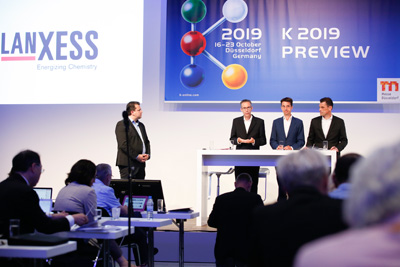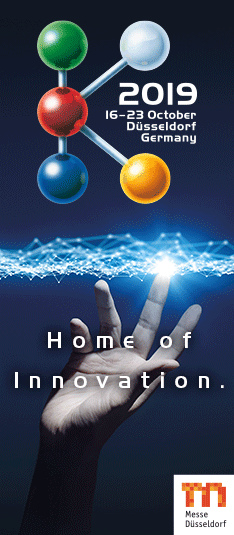| Plastics News |
Lanxess addresses the topics of new mobility, urbanization and digitalization at “K 2019”
Six business units will present new products, processes and technologies July, 2, 2019 - Lanxess will be presenting a broad portfolio at the international trade fair for plastics and rubber K 2019. On its 700 square meter stand, the specialty chemicals company will focus primarily on the topics of new mobility, urbanization and digitalization. “Innovative mobility solutions and modern urban concepts are currently being developed worldwide. These are important growth areas for us and our customers. We are constantly developing sustainable material solutions and technologies for this purpose and are also focusing on new possibilities for digitalization,” explained Hubert Fink, member of the Lanxess board of management. All in all, six of Lanxess’s eleven business units – High Performance Materials, Urethane Systems, Polymer Additives, Rhein Chemie, Inorganic Pigments and Advanced Industrial Intermediates – will be showcasing their products at K 2019. Polyamides and polyesters for sustainable mobility The High Performance Materials (HPM) business unit will be presenting a wide range of new products relating to electric mobility. “Our objective with our materials is to help the various types of drive system involved in electric mobility to break through on the market. We are focusing on a series of different technologies, from mild hybrid and plug-in hybrid to electric-only vehicles. Our developments are also aimed at additional mobility trends such as autonomous driving and digital connectivity,” said Michael Zobel, head of HPM. New HPM materials include orange, heat-stabilized compounds for high-voltage applications; materials that prevent electrical corrosion upon contact with live metal parts; and halogen-free, flame-retardant materials for components such as battery cell holders and cover plates. In terms of lightweight design, Lanxess is working primarily on hollow-profile hybrid technology and thermoplastic composites under the Tepex brand. As Zobel explained, “Our composite material is becoming more and more established in structural lightweight construction in mass production. At K, we will be presenting an extremely durable seat shell and a highly integrated front-end carrier made from Tepex, both of which exhibit an excellent crash resistance.” Investment in blow-molding system Also due to be on show at K are new compounds for blow-molding of components for air management in turbocharged combustion engines and of liners for vehicles powered by hydrogen and natural gas. “At our technical center in Dormagen, we have commissioned a state-of-the-art blow-molding system and set up a global team tasked with developing materials for special applications,” said Zobel. Products to suit growing urbanization For connectors and switches in state-of-the-art smart home systems, the polyamide 6 compound named Durethan BG60XXF is an ideal solution, Lanxess claims. According to the company, this is a very low-warpage plastic, and its uses include switch holders in the Living Now product range from Bticino, an Italian manufacturer of electronic components. Lanxess says that the component meets extremely high standards of planarity, dimensional tolerance and rigidity. The Urethane Systems business unit, a provider of polyurethane (PU) prepolymers tailored to specific customers and applications and used for elastomers, coatings, adhesives and sealants, will be focusing on its low free (LF) technology at K. This is used to formulate PU prepolymers that contain less than 0.1 percent by weight of free isocyanate and fulfill the very strictest industrial hygiene requirements, Lanxess says. “These Adiprene LF prepolymers will therefore not be affected by the forthcoming EU-wide restrictions on diisocyanates. At the same time, they improve the mechanical properties of the PU end products. In the future, we will therefore be offering all products in the Adiprene LF range, including MDI-based items, with isocyanate contents of less than 0.1 percent,” explained Markus Eckert, head of Urethane Systems. According to Lanxess, highlights of the business unit’s line-up at the trade show will include a roller coaster car with abrasion-resistant and dynamically resilient PU wheel coatings based on Adiprene LF pPDI as well as very hard-wearing, thermally stable and moisture-resistant star wheels based on Adiprene LF TDI for conveyor and separator systems in modern recycling facilities. New flame retardants for insulating materials The Polymer Additives business unit (PLA) is a provider of products such as bromine- and phosphorus-based flame retardants. It will be presenting two flame retardants for rigid polyisocyanurate (PIR) foam that, according to Lanxess, have achieved exceptional results in fire tests in line with ISO 11925-2 – the oligomeric Levagard 2000 and the reactive Levagard 2100. “What puts them ahead of other systems with similar flame-retardant effects is that they are barely volatile, if at all, and exhibit only minor plasticizing effects,” explained Karsten Job, head of PLA. In Emerald Innovation 3000, meanwhile, Lanxess offers a polymeric brominated flame retardant for expanded polystyrene that makes an alternative to hexabromocyclododecane (HBCD), which is not approved for use in the EU. Effectively protecting against ozone, reinforcing rubber and reflecting IR light Antioxidants and antiozonants will be taking center stage for the Advanced Industrial Intermediates business unit at K. Vulkazon AFS is an antiozonant for latex, natural rubber and synthetic rubber that prevents cracking caused by the effects of ozone and does not lead to staining. The Rhein Chemie business unit will be showcasing new aramid-fiber-reinforced masterbatches from the Rhenogran P91-40 series for manufacturing technical rubber goods, such as heat-resistant, durable and abrasion-resistant silicone items such as washers and seals. The Inorganic Pigments business unit will be presenting a black pigment that, according to Lanxess, reflects the infrared portion of sunlight 20 percent more effectively than conventional black pigments. Plastic roofs and facades offer a wealth of potential for use in reducing temperatures inside buildings. Artificial intelligence in product development Lanxess is aiming to make even better use of the benefits of digital technologies in the future: with digital business models, the introduction of new technologies throughout the value chain and the analysis and use of large amounts of data. The company is employing artificial intelligence (AI) to optimize formulations for glass-fiber sizings used to reinforce plastics. Lanxess is collaborating in this project with Citrine Informatics, an AI company based in Redwood City, California, U.S. Michael Zobel, head of HPM, explained: “We want to cut the development time for optimized formulations by more than half so that we can bring new, higher-performance products to market more quickly.” Circular economy with all partners in the value chain Lanxess says it is committed to establishing closed-loop material cycles in the manufacture and application of plastics. The company is currently working with customers and their own buyers on initiating pilot projects in the field. As Zobel explained, “Setting up material cycles that conserve resources in this way will work only if all partners in the value chain work together. One of our goals is to design plastics from the outset in such a way that they are easy to recycle.” Lanxess is a leading specialty chemicals company with sales of EUR 7.2 billion in 2018. The company currently has about 15,500 employees in 33 countries and is represented at 60 production sites worldwide. The core business of Lanxess is the development, manufacturing and marketing of chemical intermediates, additives, specialty chemicals and plastics.
|


